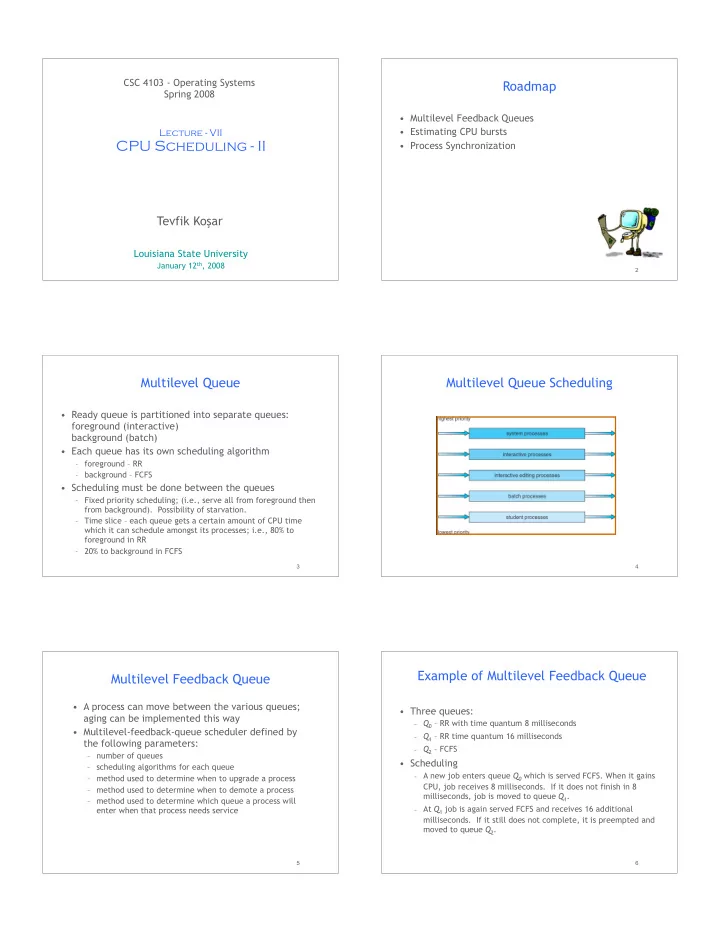

CSC 4103 - Operating Systems Roadmap Spring 2008 • Multilevel Feedback Queues • Estimating CPU bursts Lecture - VII CPU Scheduling - II • Process Synchronization Tevfik Ko � ar Louisiana State University January 12 th , 2008 1 2 Multilevel Queue Multilevel Queue Scheduling • Ready queue is partitioned into separate queues: foreground (interactive) background (batch) • Each queue has its own scheduling algorithm – foreground – RR – background – FCFS • Scheduling must be done between the queues – Fixed priority scheduling; (i.e., serve all from foreground then from background). Possibility of starvation. – Time slice – each queue gets a certain amount of CPU time which it can schedule amongst its processes; i.e., 80% to foreground in RR – 20% to background in FCFS 3 4 Example of Multilevel Feedback Queue Multilevel Feedback Queue • A process can move between the various queues; • Three queues: aging can be implemented this way – Q 0 – RR with time quantum 8 milliseconds • Multilevel-feedback-queue scheduler defined by – Q 1 – RR time quantum 16 milliseconds the following parameters: – Q 2 – FCFS – number of queues • Scheduling – scheduling algorithms for each queue – A new job enters queue Q 0 which is served FCFS. When it gains – method used to determine when to upgrade a process CPU, job receives 8 milliseconds. If it does not finish in 8 – method used to determine when to demote a process milliseconds, job is moved to queue Q 1 . – method used to determine which queue a process will – At Q 1 job is again served FCFS and receives 16 additional enter when that process needs service milliseconds. If it still does not complete, it is preempted and moved to queue Q 2 . 5 6
Determining Length of Next CPU Burst Multilevel Feedback Queues • Can only estimate the length • Can be done by using the length of previous CPU bursts, using exponential averaging + 7 8 Examples of Exponential Averaging Exercise • � =0 – � n+1 = � n – Recent history does not count • � =1 – � n+1 = � t n – Only the actual last CPU burst counts • If we expand the formula, we get: � n +1 = � t n +(1 - � ) � t n -1 + … +( 1 - � ) j � t n - j + … +( 1 - � ) n +1 � 0 • Since both � and (1 - � ) are less than or equal to 1, each successive term has less weight than its predecessor 9 10 Prediction of the Length of the Next CPU Burst Process Synchronization Alpha = 1/2, T0 = 10 11 12
Background Producer • Concurrent access to shared data may result in data while (true) inconsistency /* produce an item and put in nextProduced • Maintaining data consistency requires mechanisms while (count == BUFFER_SIZE) to ensure the orderly execution of cooperating ; // do nothing processes buffer [in] = nextProduced; • Consider consumer-producer problem: in = (in + 1) % BUFFER_SIZE; – Initially, count is set to 0 count++; – It is incremented by the producer after it produces a new buffer } – and is decremented by the consumer after it consumes a buffer. 13 14 Consumer Race Condition • count++ could be implemented as while (1) register1 = count register1 = register1 + 1 { count = register1 while (count == 0) • count-- could be implemented as register2 = count ; // do nothing register2 = register2 - 1 count = register2 nextConsumed = buffer[out]; out = (out + 1) % BUFFER_SIZE; • Consider this execution interleaving with “count = 5” initially: count--; S0: producer execute register1 = count {register1 = 5} S1: producer execute register1 = register1 + 1 {register1 = 6} /* consume the item in nextConsumed S2: consumer execute register2 = count {register2 = 5} } S3: consumer execute register2 = register2 - 1 {register2 = 4} S4: producer execute count = register1 {count = 6 } S5: consumer execute count = register2 {count = 4} 15 16 Summary Acknowledgements • “Operating Systems Concepts” book and supplementary Hmm. • Multilevel Feedback Queues material by A. Silberschatz, P . Galvin and G. Gagne • Estimating CPU bursts . • Process Synchronization • “Operating Systems: Internals and Design Principles” book and supplementary material by W. Stallings • “Modern Operating Systems” book and supplementary material by A. Tanenbaum • Next Lecture: Process Synchronization • Reading Assignment: Chapter 6 from Silberschatz. • R. Doursat and M. Yuksel from UNR 17 18
Recommend
More recommend